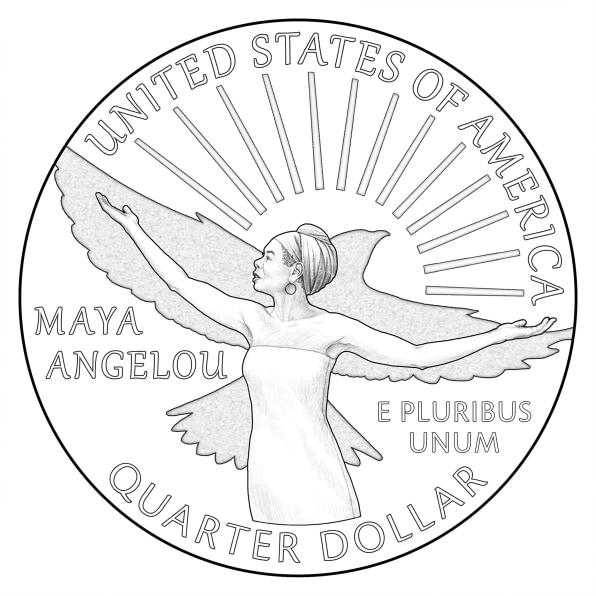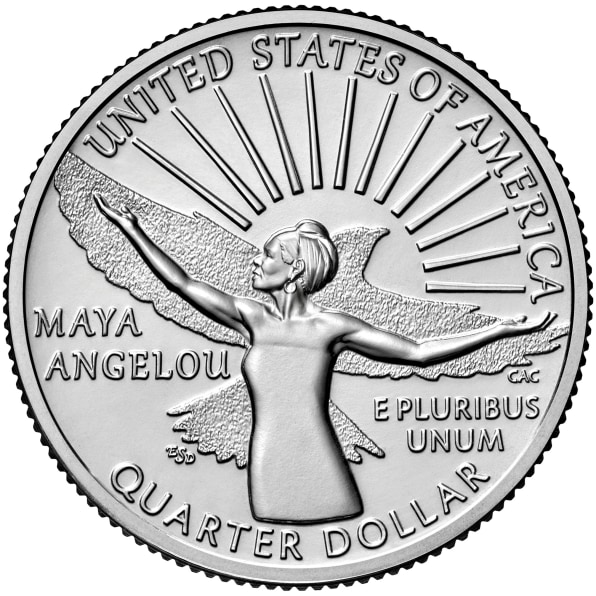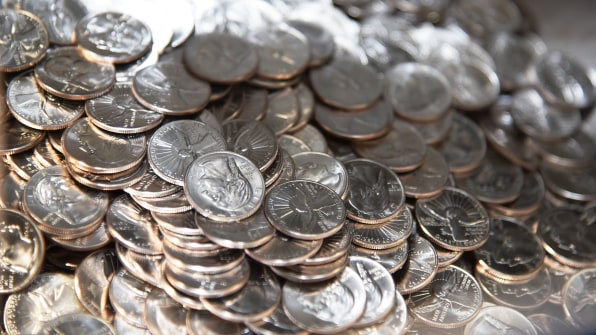How to read between the lines of an illustration celebrating Angelou’s impact and legacy.

In 1993, poet and author Maya Angelou became the first African American woman in U.S. history to recite the presidential inaugural poem for President Bill Clinton. Earlier this month, she also became the first African American woman to appear on the “tails” side of a U.S. coin. But how does one portray Angelou’s tremendous legacy on a coin that’s less than an inch in diameter?
The new quarter is part of the American Women Quarters Program, created to honor 20 notable women in U.S. history with a series of newly designed quarters to be issued by the U.S. Mint between 2022 and 2025. (This year’s additional honorees are Sally Ride, Wilma Mankiller, Nina Otero-Warren, and Anna May Wong.) Angelou’s coin was designed by Emily Damstra, an artist and illustrator who has designed more than 40 coins and medals for the U.S. Mint—including the quarter for Anna May Wong—and the Royal Canadian Mint.


A bird in flight and the rising sun were common themes in Angelou’s writing, but for Damstra, they are also “symbolic of the way she lived.” The bird is modeled after a purple martin, a songbird native to Arkansas, where Angelou grew up. “Purple martins are elegant aerial foragers that spend their days swooping and gliding high in the sky,” says Damstra. “I thought this would be a good species to illustrate Dr. Angelou’s poem.”


Once designed, the Maya Angelou quarter was sculpted by the Mint’s medallic artist, Craig A. Campbell, who also sculpted Nina Otero-Warren’s quarter, to be released later this year. Campbell started by sculpting an initial model out of clay and plaster, then used digital software to polish the final design.
Campbell explains that sculptors have to follow the designer’s illustration, but “there is always a level of creativity in every stage of the process,” he says. For example, the Otero-Warren quarter features the New Mexico suffragist in a sitting position, her hands crossed near a trifecta of flowers. The words Voto para la mujer (translation: vote for women) appear to the right of her face.
Campbell’s first task was to single out every design element and figure out the hierarchy between them. “You decide what element is the closest to you then work your way backward,” he says. In Otero-Warren’s case, the flowers were most prominent, followed by her hands, body, and the letters. (With Maya Angelou’s quarter, he says, her body came first, then the bird and the sun’s rays.)
Once the sculpture is complete, the Mint uses the digital model to carve the design into a stamp called a die, which ends up striking the quarters at a rate of 720 coins per minute. The Angelou quarter was minted in Philadelphia, Denver, and San Francisco. With 65 presses, the Philadelphia Mint produces 46,800 coins per minute, making these among the most intricately designed, mass-produced objects in design history.
"behind" - Google News
January 26, 2022 at 07:00PM
https://ift.tt/3FWeKYM
The fascinating design story behind the new Maya Angelou quarters - Fast Company
"behind" - Google News
https://ift.tt/2YqUhZP
https://ift.tt/2yko4c8
Bagikan Berita Ini














0 Response to "The fascinating design story behind the new Maya Angelou quarters - Fast Company"
Post a Comment